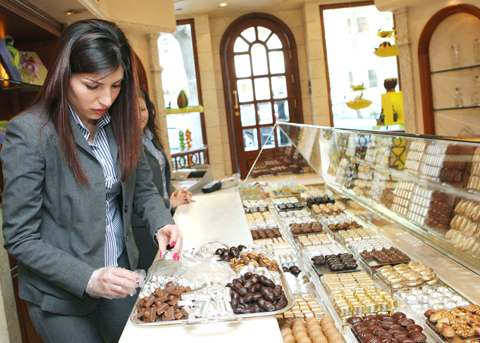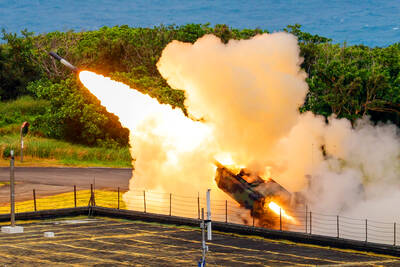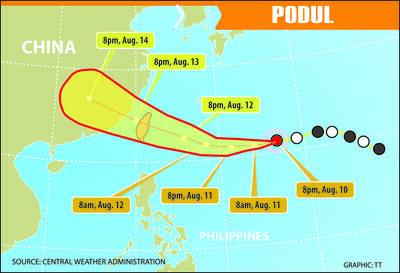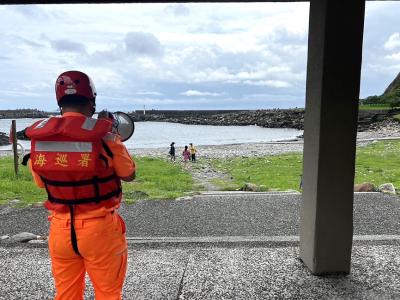Belgium and Switzerland may be the current kings of chocolate, but Syrian confectioners believe another country deserves to be up there too, and already they are feeding an international sweet tooth.
Syria’s traditional Arabic sweets are loved across the Middle East, and its people are famed for their culinary skills, with a rich cuisine built on the abundant produce of Damascus’ fertile green belt, the Ghouta, but few realize it also makes first-class chocolate, with an export industry that is booming as the Syrian economy opens up to the world.
Despite long having had a reputation as the bad boy of Middle East politics, Syria is slowly emerging from international isolation, and among those taking the lead are Syrian confectioners.

PHOTO: AFP
“Why Syrian chocolate? Why not? What do countries like Switzerland and Belgium have that we in Syria don’t have to make chocolate?” said Bassam Ghraoui, who heads Syria’s most famous chocolate maker.
“It’s a big challenge, but the fact that we produce luxury chocolate which is double the price of Belgian chocolate, for example, is a sweet surprise for many people” because the high price reflects its high quality, he said.
The civil-engineer-turned-entrepreneur said his father, Sadek, was the first to manufacture chocolate in the Middle East in the early 1930s.
Ghraoui, which also has shops in Arab countries, also sells dried fruits in Europe, including in outlets such as Harrods department store in London, and in Russia.
Now, however, the family firm is facing competition from others such as Zenbarakji and Art Chocolate, which have also made forays into the global market.
“The Syrians have a rich heritage. We import cocoa from Africa, hazelnuts from Turkey and the rest is all Syrian,” Ghraoui said of other local ingredients such as fruit and more nuts.
In 2005, his firm won the prestigious Prix d’Honneur for “best foreign chocolate” at the Salon du Chocolat in Paris, the world’s largest annual chocolate show.
“At one Paris show, we ran out of chocolate samples because people loved our products,” Ghraoui said, adding that 60 percent of the firm’s production is exported — and that figure could hit 80 percent in the future.
Ghraoui says it sells more than 30 tonnes of chocolate a year to online customers in France alone through the Web sites of European partners.
No government figures are available about the size of Syria’s chocolate industry.
Other Syrian chocolatiers and confectioners are also making their mark.
“My father started to produce chocolate and other sweets in 1936, and our business has developed to this day,” said Said Zenbarakji, owner of the Damascus-based Zenbarakji Company for Processing and Developing Chocolate and Sweets.
“The real competition started in 1990, when the company began to export chocolate to Arab countries like Lebanon, Egypt, Saudi Arabia and Qatar,” he said of the family firm’s decision to take on other local firms.
About 10 years ago, Zenbarakji also began sending its wares abroad to Europe, Canada, Brazil and Hong Kong.
“Our products are entirely made in Syria, and there is no doubt that Syrian chocolate can compete and is in demand abroad,” he said.
Khalid Sammani, owner of the Aleppo-based Art Chocolate company, another family business that was launched in 1923, said “we face strong competition locally and internationally.”
“We sell our chocolate in Arab countries, America and Canada, and it’s not an easy thing to do, but Syrian chocolate is still in demand and we are making progress,” he said.
At home, the customer base remains strong.
“It’s so good, and I am almost addicted to it,” said one cheerful woman at a Ghraoui shop in Damascus as she ate a piece of palmyra — dates filled with almond and coated with dark chocolate.
“It doesn’t help me diet as you can see, but I can’t help it,” she said of the luscious specialty, named after Syria’s ruined and famed desert city on the ancient Silk Road from China to the Mediterranean.

DEFENSE: The first set of three NASAMS that were previously purchased is expected to be delivered by the end of this year and deployed near the capital, sources said Taiwan plans to procure 28 more sets of M-142 High Mobility Artillery Rocket Systems (HIMARS), as well as nine additional sets of National Advanced Surface-to-Air Missile Systems (NASAMS), military sources said yesterday. Taiwan had previously purchased 29 HIMARS launchers from the US and received the first 11 last year. Once the planned purchases are completed and delivered, Taiwan would have 57 sets of HIMARS. The army has also increased the number of MGM-140 Army Tactical Missile Systems (ATACMS) purchased from 64 to 84, the sources added. Each HIMARS launch pod can carry six Guided Multiple Launch Rocket Systems, capable of

Authorities have detained three former Taiwan Semiconductor Manufacturing Co (TMSC, 台積電) employees on suspicion of compromising classified technology used in making 2-nanometer chips, the Taiwan High Prosecutors’ Office said yesterday. Prosecutors are holding a former TSMC engineer surnamed Chen (陳) and two recently sacked TSMC engineers, including one person surnamed Wu (吳) in detention with restricted communication, following an investigation launched on July 25, a statement said. The announcement came a day after Nikkei Asia reported on the technology theft in an exclusive story, saying TSMC had fired two workers for contravening data rules on advanced chipmaking technology. Two-nanometer wafers are the most

TRAJECTORY: The severe tropical storm is predicted to be closest to Taiwan on Wednesday and Thursday, and would influence the nation to varying degrees, a forecaster said The Central Weather Administration (CWA) yesterday said it would likely issue a sea warning for Tropical Storm Podul tomorrow morning and a land warning that evening at the earliest. CWA forecaster Lin Ting-yi (林定宜) said the severe tropical storm is predicted to be closest to Taiwan on Wednesday and Thursday. As of 2pm yesterday, the storm was moving west at 21kph and packing sustained winds of 108kph and gusts of up to 136.8kph, the CWA said. Lin said that the tropical storm was about 1,710km east of Oluanpi (鵝鑾鼻), Taiwan’s southernmost tip, with two possible trajectories over the next one

Tropical Storm Podul strengthened into a typhoon at 8pm yesterday, the Central Weather Administration (CWA) said, with a sea warning to be issued late last night or early this morning. As of 8pm, the typhoon was 1,020km east of Oluanpi (鵝鑾鼻), Taiwan’s southernmost tip, moving west at 23kph. The storm carried maximum sustained winds of 119kph and gusts reaching 155kph, the CWA said. Based on the tropical storm’s trajectory, a land warning could be issued any time from midday today, it added. CWA forecaster Chang Chun-yao (張竣堯) said Podul is a fast-moving storm that is forecast to bring its heaviest rainfall and strongest